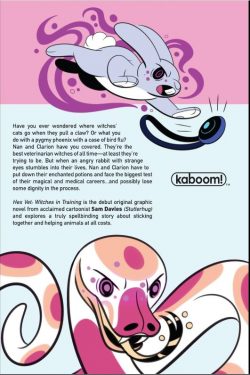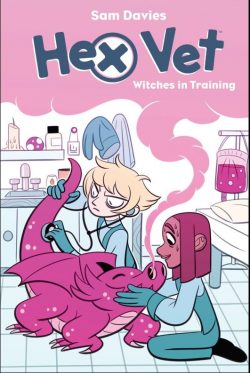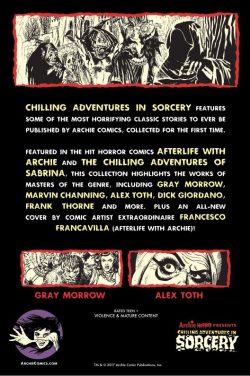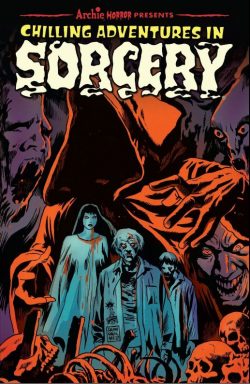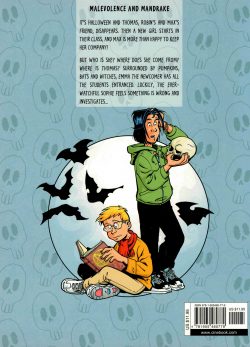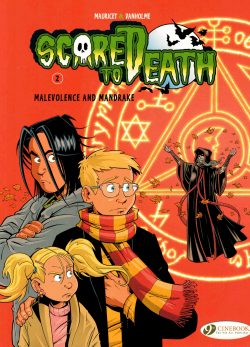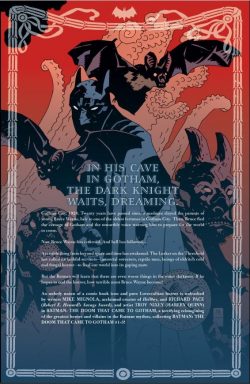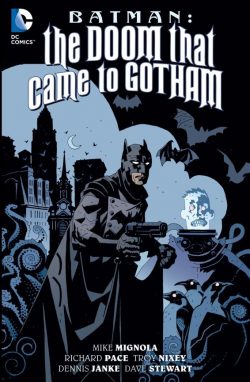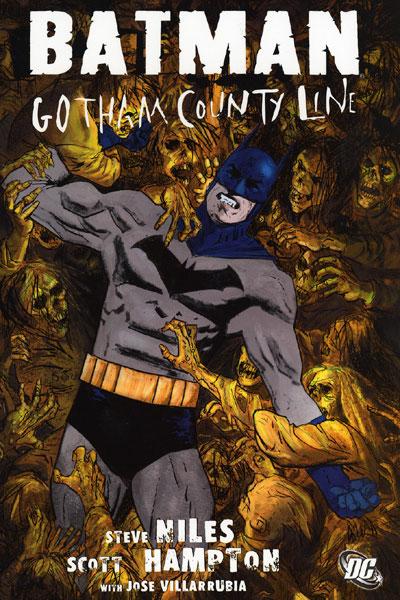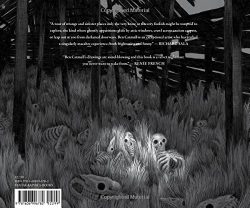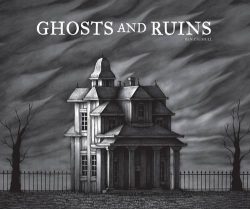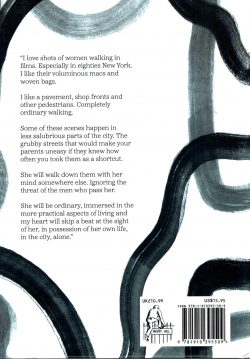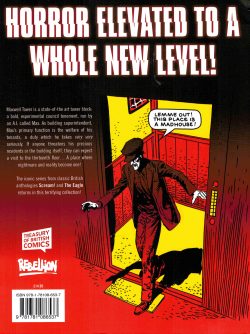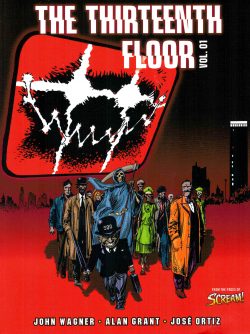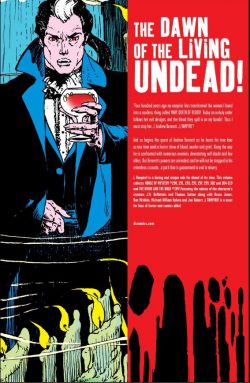
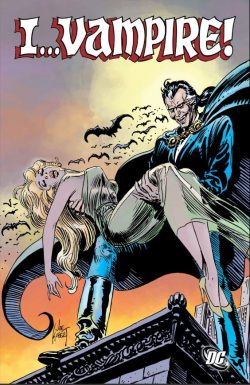
By J.M. DeMatteis, Bruce Jones, Dan Mishkin, Gary Cohn, Mike W. Barr, Tom Sutton, Ernie Colon, Adrian Gonzales, Paris Cullins, Dan Day, Jim Aparo & various (DC Comics)
ISBN: 978-1-4012-3371-6 (TPB)
When superheroes entered their second decline at the end of the 1960s, four of the six surviving newsstand comicbook companies (Archie, Charlton, DC, Gold Key, Harvey and Marvel) increasingly turned to horror and suspense anthologies to bolster their flagging sales. Even wholesome Archie briefly produced Red Circle Sorcery/Chillers comics, diverting a portion of their teen-comedy core gently into tales of witchcraft, mystery and imagination.
DC’s first generation of mystery titles blossomed at the end of the first Heroic Age when most comicbook publishers of the era began releasing Crime, Romance, Western and Horror genre anthologies to recapture an aging readership which was drifting away to other mass-market entertainments like television and movies.
After a few tenuous attempts with supernatural-themed heroic leads in established titles (Johnny Peril in Comic Cavalcade, All-Star Comics and Sensation Comics; Dr. Terry Thirteen, The Ghostbreaker in Star-Spangled Comics) in 1951 National Comics bowed to the inevitable and launched a comparatively straight-laced anthology sans recurring stars – which nevertheless became one of their longest-running and most influential titles – with the December 1951/January 1952 launch of The House of Mystery.
When a hysterical censorship scandal led to witch-hunting hearings attacking comicbooks and newspaper strips (feel free to type Senate Subcommittee on Juvenile Delinquency, April-June 1954 into your search engine at any time) the industry panicked and hurriedly adopted a castrating straitjacket of stringent self-regulatory rules and admonitions.
Even though mystery/suspense titles produced under the aegis of the Comics Code Authority were sanitised, anodyne affairs in terms of Shock and Gore, the appetite for mystery and suspense was still high, and in 1956 National introduced sister titles Tales of the Unexpected and House of Secrets.
Supernatural thrillers and spooky monster stories were dialled back into marvellously illustrated, genteel, rationalistic fantasy-adventure vehicles which nonetheless dominated the market until the end of the 1950s when the super-hero returned in force – having begun a renaissance after Julius Schwartz reintroduced the Flash in Showcase #4, 1956.
Revivals of Green Lantern, Hawkman, The Atom and a host of new costumed cavorters generated a gaudy global bubble of masked myrmidons which even forced these dedicated anthology suspense titles to transform into super-character split-books with J’onn J’onzz, Manhunter from Mars and Dial H for Hero in House of Mystery and paranormal investigator Mark Merlin (latterly Prince Ra-Man) sharing space with anti-hero Eclipso in House of Secrets.
When the caped crusader craziness peaked and popped, Secrets was one of the first casualties, folding with the September-October 1966 issue. House of Mystery carried on with its eccentric costumed cohort until #173, and Tales of the Unexpected carried on until #104.
However, nothing combats censorship better than falling profits, and at the end of the 1960s the superhero boom busted again. With many once-popular titles gone and some of the industry’s most prestigious series circling the drain too, this real-world Crisis led to the surviving publishers of the field agreeing to loosen their self-imposed restraints against crime and horror comics. Nobody much cared about gangster titles at the time, but as this liberalisation coincided with another bump in global public interest in all aspects of the Great Unknown, the resurrection of scary story comics was a foregone conclusion and obvious “no-brainer.â€
Thus, with absolutely no fanfare at all House of Mystery and Unexpected switched back to tales of magic, mystery and imagination stories and House of Secrets rose again with issue #81, (cover-dated August-September 1969): retasked and retooled to cater to a seemingly insatiable appetite for terror and suspense yarns…
Before long, an expansive battalion of supernatural thriller titles dominated DC – and other companies’ – publishing schedules again. This time, however, although the initial impetus died out by 1978, horror comic books had secured a dedicated audience, and soldiered on despite a decline in sales into the turbulent 1980s.
During that period, the venerable periodical experimented with varying formats and became a springboard for many creative careers, but never returned to established, recurring heroes until the reign of publishing whiz kid Karen Berger who officially assumed control with #292. A few issues earlier, a new longform miniseries had debuted, detailing the exploits of a reluctant monster seeking to atone for past sins…
The full groundbreaking tragic, idiosyncratic saga has been gathered into a sinister trade paperback – or digitally formatted – chronicle collecting the adventures of the bloodsucker and his human allies as first seen in House of Mystery #290-291, 293, 295, 297, 299, 302, 304-319 as well as a fast-paced guest-shot in The Brave and the Bold #195, cumulatively spanning March 1980 to August 1983 and opens without fanfare or preamble with ‘I… Vampire’ by co-creators J.M. DeMatteis & Tom Sutton.
In ten tightly-packed but smoothly inviting pages we are introduced to English noble Sir Andrew Bennett, who died at the hands of a nosferatu during the reign of Queen Elizabeth I. Beloved by his fiancée, Mary Seward, Bennett succumbs to her desperate pleas to be similarly infected, her so their love could last forever. Only afterwards does he realise that the transformation creates soulless monsters, but, somehow, he has retained his conscience and personality…
Over four centuries, “Bloody Mary†becomes a leader of vampires in an insidious, influential covert global cult dubbed the Blood Red Moon, spreading chaos and destruction whilst working towards their ultimate goal of vampires ruling a world of human cattle. Heartbroken and guilt ridden, Bennett opposes her schemes for all that time, aided by human allies such as his most recent daywalkers: aged Russian warrior Dimitri Mishkin and go-getting “Eighties Woman†Deborah Dancer…
Empowered by all the traditional gifts of the undead (shapeshifting, supernatural vigour, hypnosis, etc) and similarly afflicted by their weaknesses (sunlight, crucifixes, Holy Water, stakes et al) Bennett staves off his insatiable hunger for blood by sheer willpower and the determination that he will not die until he has ended Mary’s depredations…
The introductory episode covers all that even as Mary’s minions lose another running battle with Bennett’s team but escape to instigate their latest plan…
The adventure concludes in ‘Night of the Living Undead’ as team Bennett expose and end a proposed alliance between the cult and New York’s biggest drug dealer after which ‘The Burning’ sees the hunters scotch a scheme to infiltrate the White House after Mary affiliates with a race-hate spouting demagogue with links to the KKK and the President…
The closure of that case tears open old wounds, as Mishkin subsequently clashes with one of Mary’s lieutenants only to discover a dreaded family connection in ‘Mother Love/Mother Hate’, leading to a look into how Bennett recruited him as a boy at the turn of the 20th century…
DeMatteis’ moves on after the dark heroes foil Mary’s attempt to destroy an ashram and its spiritual guru in ‘Zen Flesh! Zen Bones!’ after which Bruce Jones moves in, offering a more fanciful approach in ‘The Sun Also Burns’. Here Bennett and his human friends are ambushed and left to die in a mine. As time passes, the valiant vampire – deprived of bottled blood – must battle his irresistible thirst, before abandoning them. Resolved never to endanger them again, he sets out on a solo quest for vengeance…
‘Blood Ties’ in HoM #302 sees that lonely walkabout take him to Eudora, Kansas where strange events culminate in Bennett causing the accidental death of an entire family of innocents before stumbling across a predatory circus abducting innocents for profit, and sponsored by Bloody Mary. His war against the ‘Carnival of Souls’ lasts until #304 where – with Ernie Colon substituting for Sutton – Bennett learns that ‘The Night Has Eyes’ and proves that he has no pity for child stealers…
Jones kicks off a lengthy saga in ‘Blood and Sand’ as the still-solo Bennett tracks Mary’s agents to Egypt in the wake of a global anti-cancer vaccine rollout that has the unexpected side-effect of making human blood toxic to the undead…
Meanwhile, and for all this time, Mishkin and Dancer have been hunting for their leader, and are closing in…
Made unwilling allies by fate, Andrew and Mary invade a lost tomb, where the cult queen steals the time-travelling Rings of Anubis from a mystic mummy and sets off to the past to undo the creation of the vaccine. In hot pursuit, thanks to a second ring, Bennett arrives in Whitechapel, London at the height of history’s most infamous serial killer spree.
Crafted by Jones and the returned Sutton, ‘A Rip in Time’ sees all Mary’s efforts thwarted, and the ancestor of mysterious vaccine creator Dr. Barr escape unharmed, even as the vampires are hurled back into the time stream…
Bennett washes ashore in Maine in November 1964, just in time to save a little girl from drowning. ‘Lovers Living, Lovers Dead’ reveals that in the present Deborah Dancer has developed a psychic link and can “see†the vampire past actions as they happen. She is suitably horrified to observe Mary then attack the child and aghast to realise that the child is herself…
After a heroic intervention from Bennett saves the girl, the time chase pauses as the undead knight battles a crew of revenant Nazi submariners in ‘Mirrors That Look Back’ before his pursuit resumes, depositing him and his quarry in Elizabethan England mere days before their first deaths…
A bewildering succession of time-tossed doubles and mistaken identity switches culminates in a deadly ‘Witch Hunt’ with religiously enflamed peasants running riot before all the chronal paradoxes dump them both back in the 20th century where new writers Dan Mishkin (no relation) & Gary Cohn concoct a ‘Manhattan Interlude’ (HoM #310, November 1982) foe penciller Adrian Gonzales and ever-faithful Tom Sutton to render. Here Bennett encounters another vampire who has retained both soul and innocence and regretfully helps her meet her final end on her own terms…
Paris Cullins joins Mishkin & Cohn, Gonzales & Sutton for a dark peek at Deborah Dancer’s teen years in ‘By the Time We Got to Woodstock…’, revealing how she “first†stumbled into the Blood Red Moon’s schemes of conquest after losing all her friends to hippy vampires at the legendary festival and only survived thanks to an old Russian and eerie, red-eyed Englishman…
Issue #312 reunites the trio in time to tackle ‘The Thing in the Tunnel’ (Mishkin, Cohn, Gonzales & Sutton): a predatory beast escaped from the familiar-sounding Barr Research Laboratories leading to a deadly clash with the enigmatic and extraordinarily long-lived (hint, hint) biologist in ‘Side Effects’, before ‘I.. Edward Trane, I… Vampire’ in #314 (illustrated solely by Sutton) sees a tragic reunion for Bennett with one of his Victorian acolytes who fell in battle but never fully died…
Mishkin, Cohn, Cullins & Sutton then detail an untitled exploit wherein the vampire hunters are targeted by sanctimonious religious zealots hunting he unholy. Sadly, their leader’s top aide is not only undead herself, but also Dimitri’s mother and the Presidency is once more the glittering prize being sought…
Although the plot is foiled, the cost is high, compelling Bennett to turn eastwards, and ‘Back in the U.S.S.R.’ he uncovers a KGB program to weaponize vampirism and extend the joys of eternity to the aging Politburo. The result is open warfare between Mary’s cult and a Soviet secret army, ultimately proving in ‘Blood is Thicker…’ that that not all military spending is pointless and not every hero gets to ride off into the sunset…
Despite a long run, changing times and tastes were indicating that the title and, indeed, entire genre were not a viable contemporary option. With the series building to climax, #318 offered another untitled yarn (with Dan Day pencilling) wherein a freshly bereaved Andrew Bennett employs stolen Soviet technology to force a final confrontation with Mary and the Blood Red Moon resulting in his final demise and the birth of a new kind of hero in climactic last episode ‘Dreams of Death’ by Mishkin & Cohn, & Sutton in House of Mystery #319 (August 1983).
Rather annoyingly, the big finish isn’t the end here, as there follows a solid but painfully out-of-continuity tale taken from The Brave and the Bold #195 (February 1983). In ‘Night of Blood’ – by Mike W. Barr & Jim Aparo – Bennett’s perpetual hunt for Mary brings him to Gotham City after a gangster’s daughter becomes the latest victim of a killer vampire. Batman is firmly convinced the attacks are fake – and he’s right – until an actual magic-accursed blood drinker shows up. At least this time the standard misunderstanding doesn’t result in pointless battle before reason prevails and the mismatched heroes unite to catch the real culprits…
A genuine slice of engaging, unorthodox and vastly entertaining horror action that predates – and probably influenced – later hits like Buffy the Vampire Slayer and Angel, this is a hugely enjoyable edgy romp: well-scripted, imaginative and gorgeously illustrated. Even the covers are special; crafted by industry icons Joe Kubert and Michael Wm. Kaluta.
I… Vampire is a tome for all lovers of dark delight and one no arcane aficionada can afford to be without.
© 1981, 1982, 1983, 2012 DC Comics. All Rights Reserved.

